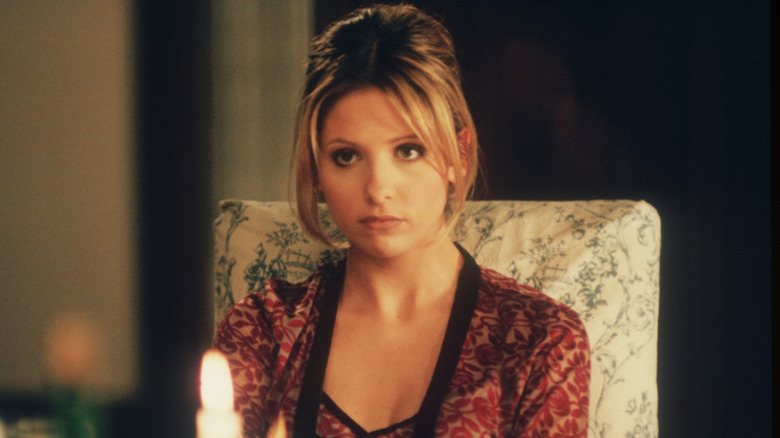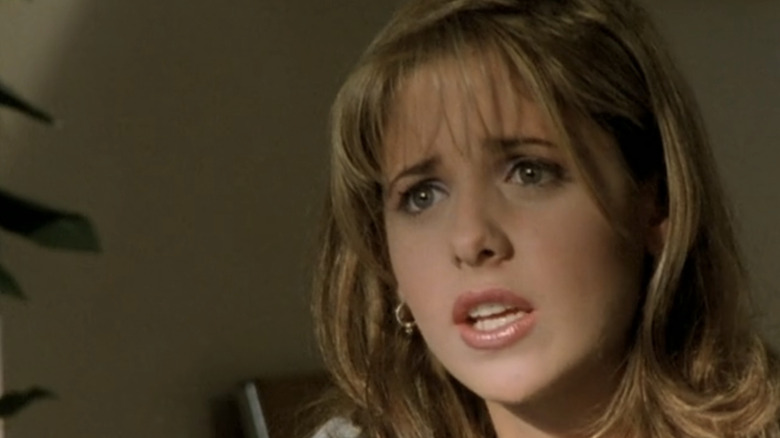Buffy The Vampire Slayer Season 1's Limited Budget Led To Some Inventive Filming Choices
We may receive a commission on purchases made from links.
If you've ever rewatched "Buffy the Vampire Slayer" Season 1 and thought, "Huh, this looks a little cheap," you're more on target than a stake lodged in a bloodsucker's heart.
In the book, "Slayers and Vampires: The Complete Uncensored, Unauthorized Oral History of Buffy and Angel," creator Joss Whedon is quoted as saying, "We were very much on a tight budget. It's really kind of sad, actually." That said, what the production team was able to pull off with its limited means was impressive.
The "Buffy" crew made extensive use of a converted lumber warehouse in Santa Monica to build multiple sets for the show. In Season 1, that warehouse — which was not a professional soundstage — provided a home for several interior and exterior sets, but it wasn't the easiest place to shoot. Director of photography Raymond Stella described the less-than-ideal facilities in "Slayers and Vampires," recalling, "We didn't have any [lighting] grids to work off of [...] It made it challenging. We made it work, but we had our limitations, so it kind of tended to make it look a little low-budgety if you weren't careful."
Buffy had to work wonders without any real sound stages
"Buffy" got off to a rough start, with Joss Whedon and his crew originally producing an unaired pilot that didn't impress anyone at The WB. The only reason audiences ever got a Season 1 of "Buffy" was because the soap opera "Savannah" was canceled mid-season, and the network needed a replacement. As such, you can imagine The WB wasn't shelling out millions per episode of "Buffy," which left Joss Whedon and his crew in a tough situation.
Instead of being given space on the Warner Bros. lot, the show was handed their Santa Monica warehouses and had to make the best of it. Still, Season 1 contains some of the best "Buffy" episodes, thanks in part to some truly inventive use of the Santa Monica facilities.
Fun fact about the show's first season: Whenever you see Buffy and her friends inside at school, they're in the same spot. As Whedon explained, "This hall you'll see a lot of in the first 12 episodes. It is the entire school. We only had the one hall, so we use it over and over again."
Buffy actually expanded its warehouse sets as it went on
The crew also shot on location in Season 1. The exterior Sunnydale High School scenes, for example, were all shot at Torrance High School in California. Scenes at Buffy's house were also shot on location at an actual house in the city. The slayer's bedroom was the only interior set from the house that was built in Santa Monica during Season 1.
As the seasons progressed, the crew eventually built more house sets. The same was true of the Sunnydale cemetery. During the first season, scenes in that location were mostly shot at the real-life Angelus-Rosedale Cemetery. Later, however, the crew built a cemetery on the Santa Monica warehouse's lot. By Season 3, production designers had begun to construct an entire downtown Sunnydale strip on the grounds of the warehouse; this area became known as Maple Court.
"Buffy the Vampire Slayer" would go on to become a cult hit, though allegations that Joss Whedon ran a "toxic" set on both that series and its spin-off, "Angel," would later cast a pall of the fantasy series' legacy.


